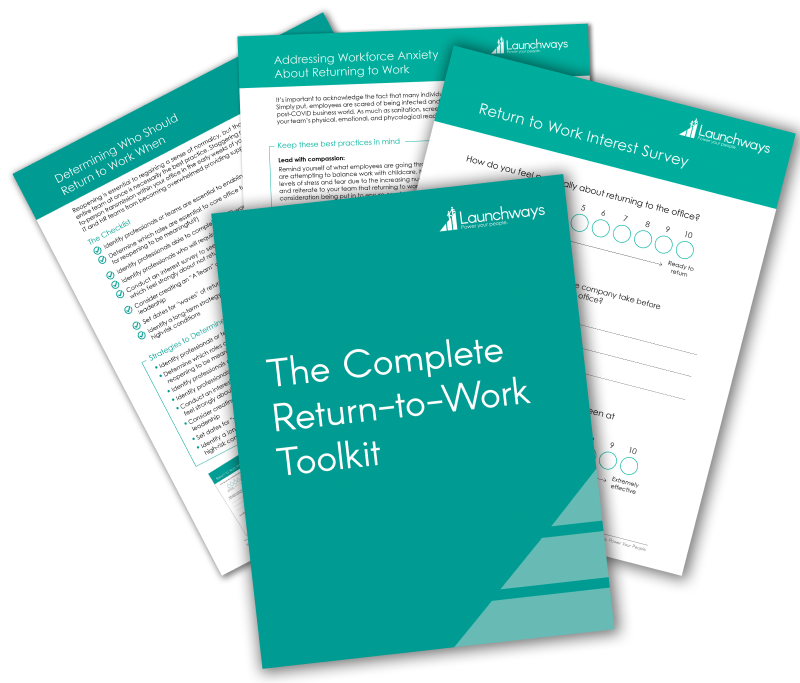With some states cautiously reopening non-essential businesses before the COVID-19 national emergency has been officially declared over, it’s crucial for the owners and managers of those businesses to get reopening right from a wellness and employee/public protection standpoint.
If we as a business community can execute this properly, then we’ll be bringing what normal looks like after COVID-19 to employees and the public at large, stimulating the reemergence of our strong American economy. However, we desperately need to talk about what reopening “right” actually looks like.
This is why Launchways created our Complete Return to Work Toolkit, a resource any business can use to plan for a successful return built on best practices and up-to-date information.
Moving forward, we’ll explore some of the concepts from the toolkit including:
- Key policy & procedural concerns related to screening employees & visitors for COVID-19
- Crucial questions about expectations for personal protective equipment that must be addressed before employees return to the office
- Modifications you need to make to your physical workspace and way of fostering collegial collaboration in order to reopen safely
Health Screenings
The most important aspect of a proper reopen is getting your team members back in their traditional workplace in a way that ensures talent is returning to the building without introducing the spread of COVID-19 within your workforce.
Here are a few examples of questions you need to be able to answer regarding health screenings before you can plan to reopen:
- What screening questions will you ask employees before they return to the office?
- What screening questions will you ask customers/clients/office guests before anticipated visits to your facility?
- What communication system will you use to transmit and manage screening questions?
- Who will be in charge of reading/assessing eligibility to return based on screening responses?
- What screening questions will you ask customers/clients/office guests before anticipated visits to your facility?
- Will you carry out temperature checks as people arrive to work?
- Where will you carry out temperature checks?
- Who will carry out temperature checks?
- What will be the temperature threshold for denying admittance to the workplace?
- What are next steps for employees for are denied entry because of failing a screening?
- How will you transition them toward leave?
- How can you enable work-from-home for those who insist they can work?
- What are next steps for customers/clients/office guests who fail a screening?
- What parameters must a COVID-19 positive employee meet before returning to the workplace (for example 14 days from diagnosis, or 72 hours without experiencing a fever)
Personal Protective Equipment (PPE)
Given that COVID-19 is often spread by asymptomatic carriers, PPE is essential to minimizing the spread of coronavirus, even between people who do not feel or appear to be sick. The use of PPE among the public is currently inconsistent, so you need to set clear expectations for usage in your workplace.
Here are just a few different questions you need clear answers to before you recall your workforce and reopen your facility:
- What PPE will public-facing employees use?
- What PPE will back-office employees use?
- Will you be issuing PPE or expecting employees to bring their own? (if employees must provide their own, will they be reimbursed?)
- How often will you expect employees to change/sanitize PPE?
- What cleaners or approaches will you approve for sanitizing PPE?
- How/where will employees dispose of soiled PPE?
- Will you require PPE for clients/customers/office guests?
- Will you make PPE available to clients/customers/office guests?
- How will you address refusal to comply with your PPE policy?
- For employees?
- For clients/customers/guests?
Social Distancing
Maintaining six feet or two meters of distance between all people remains a best practice until the official end of the outbreak period.
Here are some examples of baseline social distancing concerns you absolutely must have plans and policies in place for as you reopen:
- How will you modify the physical space of public-facing areas to enable distancing for employees and customers/clients/guests?
- How will you modify your back-office space to enable distancing for employees and guests?
- How will you create sensible traffic patterns that allow people to get around the office in ways that support distancing and prevent anybody from “squeezing past” each other in the halls? (for example, some offices are transitioning their layout to use only ‘one-way’ hallways)
- What kind of signage will you create to provide distancing reminders and where will you put it?
- How will you enable meetings, brainstorming sessions, and other collaborative group work in ways that support distancing?
- How will you address distancing with regard to the use of common spaces (kitchens, bathrooms, etc.)?
- How will you address refusal to comply with your social distancing policy?
- For employees?
- For clients/customers/guests?
How to Learn More
If you’re a business leader hoping to reopen your business or transition remote workers back to the traditional office in the coming days and weeks, be sure to download Launchways’ Complete Return to Work Toolkit!
The toolkit covers:
- How to Determine Who Should Return to Work & When
- Preparing & Modifying Your Physical Workspace
- Protocols for Employee Re-Entry & Health Screenings
- Building and Enforcing Social Distancing & COVID-Specific Employee Protocols
- How to Address Workforce Anxiety About Returning to Work
- Sample Return to Work Survey for Employees
- How to Identify & Correctly Update Effected Company Policies
- Roadmap for a Return-to-Work Communications Strategy
GET YOUR COMPLETE RETURN TO WORK TOOLKIT NOW!

